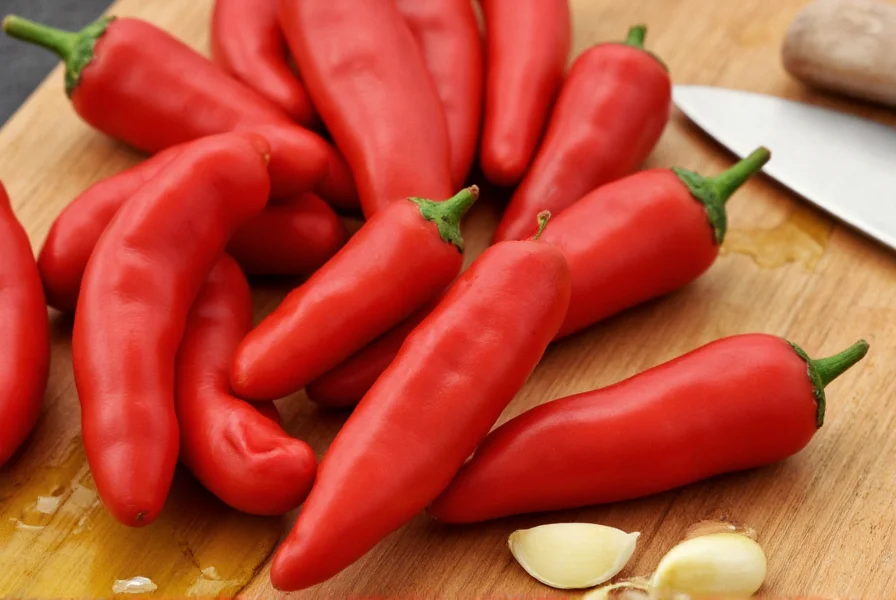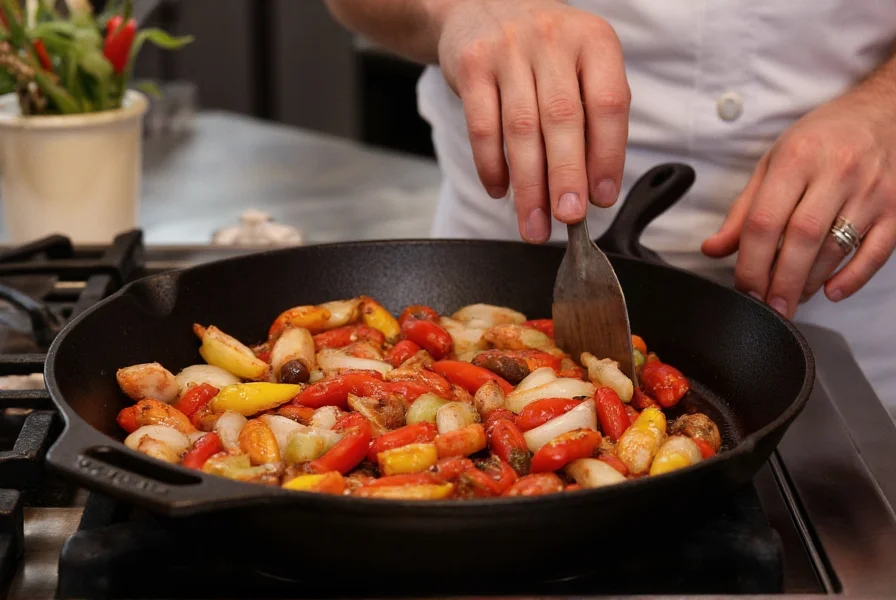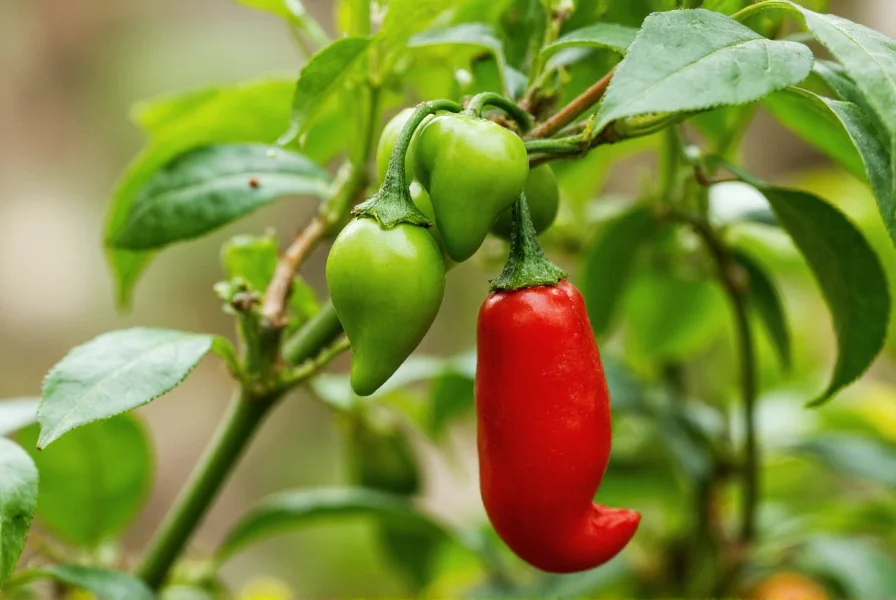Native to Spain's Basque Country, guindilla peppers (pronounced gwin-dee-yah) have been cultivated for centuries as a staple ingredient in Iberian cooking. Unlike their spicier counterparts, these slender 4-6 inch peppers deliver a balanced flavor profile that enhances dishes without overwhelming heat—making them ideal for both traditional preparations and modern culinary experimentation.
Physical Characteristics and Flavor Profile
Guindilla peppers start green and mature to a brilliant red, featuring a distinctive curved shape with a tapered tip. Their thin walls and hollow interior make them particularly suitable for drying while preserving flavor. When fresh, they offer a crisp texture with grassy notes; when dried, they develop complex smoky-sweet characteristics with subtle berry undertones.
Their heat level registers between 2,500-8,000 Scoville Heat Units (SHU), placing them milder than jalapeños (2,500-8,000 SHU) but with more complexity than bell peppers (0 SHU). This moderate heat makes guindilla peppers accessible to those with lower spice tolerance while still providing culinary interest for heat enthusiasts.

Traditional Culinary Applications
In Spanish cuisine, guindilla peppers serve multiple functions beyond mere seasoning. Chefs often use them whole in:
- Piperrada: A Basque pepper stew featuring onions, tomatoes, and guindillas
- Gildas: Skewers of olives, anchovies, and guindilla peppers
- Mojo sauces: Blended with garlic, oil, and vinegar for dipping
- Preserved preparations: Pickled in vinegar with herbs
Professional chefs typically toast dried guindillas in olive oil to release their essential oils before incorporating them into dishes—a technique that maximizes flavor extraction while controlling heat levels. The peppers are often removed before serving, functioning similarly to a bay leaf in flavor contribution.
Guindilla vs. Similar Pepper Varieties
| Pepper Variety | Heat Level (SHU) | Flavor Profile | Primary Culinary Use |
|---|---|---|---|
| Guindilla | 2,500-8,000 | Smoky-sweet with berry notes | Whole in stews, sauces, pickling |
| Padrón | 500-2,500 (mostly mild) | Grassy, vegetal | Blistered as tapas |
| Cherry Bomb | 500-2,500 | Fruity, tangy | Stuffed, pickled |
| Peperoncini | 100-500 | Sour, tangy | Pickled, sandwiches |
Understanding the differences between guindilla peppers and similar varieties like padrón peppers is crucial for authentic Spanish cooking. While padróns are typically served blistered as tapas (with the famous saying "unos pican y otros no"—some are hot, some are not), guindillas offer more consistent heat and are primarily used as flavoring agents rather than main components.
Practical Usage Tips for Home Cooks
When working with dried guindilla peppers, proper preparation enhances their culinary potential:
- Rehydration method: Soak in warm water or broth for 15-20 minutes before blending into sauces
- Dry-toasting technique: Heat in dry skillet over medium heat until fragrant (about 2 minutes)
- Infusion approach: Add whole peppers to olive oil for flavored oil (remove after 1-2 weeks)
- Seed adjustment: Remove seeds for milder flavor, retain for increased heat
For those seeking authentic guindilla pepper substitute options, consider Hungarian wax peppers for fresh applications or a combination of ancho and cherry peppers for dried preparations. The closest fresh alternative would be Italian frying peppers, though they lack the distinctive berry notes of true guindillas.

Nutritional Benefits and Storage
Like other chili peppers, guindillas contain capsaicin (associated with metabolic benefits) and are rich in:
- Vitamin C (134% of daily value per 100g)
- Vitamin A (112% of daily value)
- Vitamin B6
- Dietary fiber
- Antioxidants including carotenoids
For optimal storage, keep fresh guindillas in a perforated plastic bag in the refrigerator crisper drawer for up to two weeks. Dried peppers maintain peak flavor for 6-12 months when stored in airtight containers away from light and moisture. Freezing whole peppers preserves them for up to one year without significant flavor degradation.
Finding Authentic Guindilla Peppers
Locating genuine guindilla peppers requires knowing where to look. Specialty Spanish markets typically carry both fresh (seasonally) and dried varieties. Online retailers specializing in Iberian ingredients offer reliable sources for where to buy guindilla peppers outside Spain. When selecting dried peppers, look for deep red color, pliable texture (not brittle), and absence of mold or excessive dust.
Chefs note that authentic Spanish guindillas often bear the Denominación de Origen (DO) certification, indicating they were grown in specific regions using traditional methods. This certification ensures the distinctive flavor profile associated with true guindilla peppers rather than generic substitutes.
FAQ
Are guindilla peppers the same as padrón peppers?
No, guindilla and padrón peppers are distinct varieties. Guindillas are longer (4-6 inches), consistently mild-to-medium heat (2,500-8,000 SHU), and primarily used dried in sauces. Padróns are smaller (2-3 inches), mostly mild but occasionally hot (500-2,500 SHU), and typically served blistered as tapas with the saying "unos pican y otros no" (some are hot, some are not).
How hot are guindilla peppers compared to jalapeños?
Guindilla peppers (2,500-8,000 SHU) generally fall within the same heat range as jalapeños (2,500-8,000 SHU), but with important differences. Guindillas deliver a more gradual, smoky heat with sweet undertones, while jalapeños provide sharper, more immediate heat. Most culinary professionals consider guindillas slightly milder in perceived heat due to their flavor complexity.
Can I grow guindilla peppers myself?
Yes, guindilla pepper plants (Capsicum annuum) can be grown in home gardens with proper conditions. They require 70-90 days to maturity, full sun, well-draining soil, and consistent watering. Start seeds indoors 8-10 weeks before last frost. The plants grow 18-24 inches tall and produce slender peppers that transition from green to vibrant red when fully mature. They thrive in Mediterranean-like climates but can be grown in containers elsewhere.
What's the best way to use dried guindilla peppers?
The optimal method for using dried guindilla peppers involves toasting them in olive oil until fragrant (about 2 minutes), then adding to dishes whole for flavor infusion. Remove before serving, similar to bay leaves. For sauces, rehydrate by soaking in warm broth for 15 minutes, then blend with other ingredients. This technique maximizes their distinctive smoky-sweet flavor while controlling heat levels in traditional Spanish preparations like piperrada.
How should I store guindilla peppers for maximum freshness?
Store fresh guindilla peppers in a perforated plastic bag in your refrigerator's crisper drawer for up to two weeks. For dried peppers, use airtight containers away from light and moisture to maintain peak flavor for 6-12 months. Freezing whole fresh peppers preserves them for up to one year without significant flavor loss. Avoid storing near ethylene-producing fruits like bananas, which accelerate ripening and spoilage.











 浙公网安备
33010002000092号
浙公网安备
33010002000092号 浙B2-20120091-4
浙B2-20120091-4